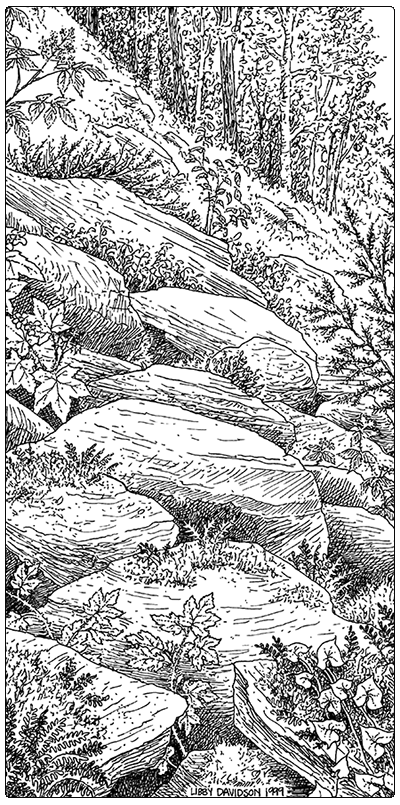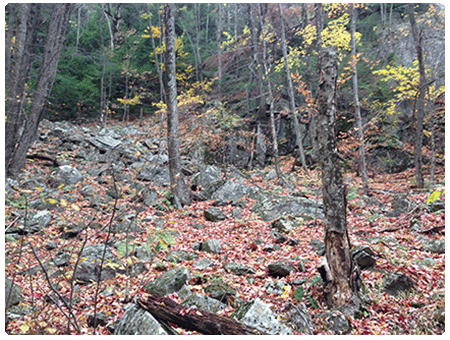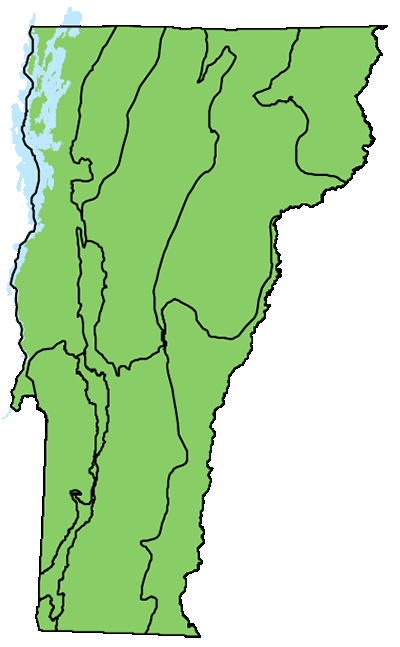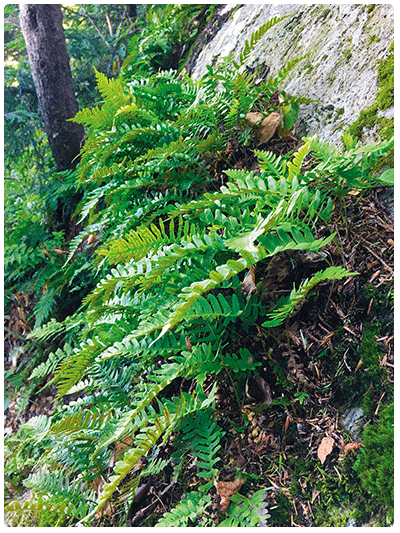Ecology and Physical Setting
Northern Hardwood Talus Woodlands are found in areas where large boulders have accumulated below cliffs or steep slopes. Anyone who has traversed a talus woodland knows the footing is precarious—deep crevices can be hidden by leaves and debris. Rockfall can be an ongoing disturbance at some sites, but at others the talus is stable and rockfall is rare. Scars and wounds on the uphill side of trees clearly tell the story of whether rockfall is a frequent event. Northern Hardwood Talus Woodlands occur as small, isolated features in the landscape and are sometimes associated with Open Talus, which usually occurs higher on the slope. At the base of such slopes, soil accumulates in the spaces between the rocks or in small concavities on large boulders. Trees that do well on rocky sites, such as yellow birch and hemlock, are common but often stunted due to the lack of soil. This community can be found on a range of bedrock types from calcareous to acidic. Even in acidic settings, the downslope soil accumulation can result in localized enrichment.
Vegetation
Trees are scattered and most do not attain great size. Mountain maple and other shrubs can form dense thickets locally. Vines such as Virginia creeper and poison ivy are well adapted to talus and are therefore common. They root in shaded crevices but send their foliage out into open sun of the bare rocks. Very few herbs do well in these woodlands; Appalachian polypody is perhaps the most successful. Mosses and lichens are frequent. The downslope movement of soil and nutrients, and the resulting enrichment, favors herbs such as white snakeroot, wood nettle, Goldie’s wood fern, and pale touch-me-not. In the canopy and shrub layers, white ash, basswood, butternut, and red-berried elder are indicators of enrichment.
Wildlife Habitat
These small patches of steep rocky woodlands support several mammal species. The rare rock vole and long-tailed shrew may spend most of their lives within the crevices and spaces of these talus slopes, venturing out locally in search of food. Porcupines and bobcats use these talus slopes as secure denning sites.
Related Communities
 Boreal Talus Woodland is similar in structure to Northern Hardwood Talus Woodland but is found at higher elevations or more northern latitudes. Red spruce and heart-leaved paper birch are present. Basswood, white ash, and sugar maple are absent, and overall diversity is lower.
Boreal Talus Woodland is similar in structure to Northern Hardwood Talus Woodland but is found at higher elevations or more northern latitudes. Red spruce and heart-leaved paper birch are present. Basswood, white ash, and sugar maple are absent, and overall diversity is lower.- Oak-Black Birch Talus Woodland is similar in structure, but is found in warmer settings on acidic bedrock. It is most common in southern Vermont. Oaks, black birch, and hophornbeam are common species.
- Oak-Maple Limestone Talus Woodland is found in areas of highly calcareous bedrock. It is richer in species than Northern Hardwood Talus Woodland and has several calciphilic species, including northern white cedar and climbing fumitory.
- Rich Northern Hardwood Forest is often associated with Northern Hardwood Talus Woodland that is found on calcareous bedrock. It has deeper soils and generally lacks accumulated talus, allowing for the development of a closed forest canopy and tall trees. These two communities share many species, including white snakeroot, wood nettle, and Goldie’s wood fern.
Conservation Status and Management Considerations
In general, talus woodlands are not threatened communities because they are unsuitable for forestry, agriculture, or development. But because they are uncommon, representative examples should be protected. If trees are harvested, logging should be done with care to minimize soil erosion.
Distribution/Abundance
Northern Hardwood Talus Woodlands are found throughout Vermont, at elevations to 2,500 feet. They occur across the Northeast.
Characteristic Plants
Trees
Abundant Species
Yellow Birch – Betula alleghaniensis
White Ash – Fraxinus americana
Paper birch – Betula papyrifera
Occasional to Locally Abundant Species
Sugar maple – Acer saccharum
Basswood – Tilia americana
Eastern hemlock – Tsuga canadensis
Red oak – Quercus rubra
Butternut – Juglans cinerea
Shrubs
Abundant Species
Mountain Maple – Acer spicatum
Red-berried elder – Sambucus racemosa
Occasional to Locally Abundant Species
Canada yew – Taxus canadensis
Bristly black currant – Ribes lacustre
Purple-flowering raspberry – Rubus odoratus
Red raspberry – Rubus idaeus
Round-leaved Dogwood – Cornus rugosa
Herbs and Vines
Abundant Species
Virginia Creeper – Parthenocissus quinquefolia
Appalachian polypody – Polypodium appalachianum

rocky outcrops in talus woodlands.
"
Occasional to Locally Abundant Species
Marginal wood fern – Dryopteris marginalis
Rusty woodsia – Woodsia ilvensis
Fringed bindweed – Fallopia cilinodis
Poison ivy – Toxicodendron radicans
Wood nettle – Laportea canadensis
White snakeroot – Ageratina altissima
Clearweed – Pilea pumila
Pale touch-me-not – Impatiens pallida
Ostrich fern – Matteuccia struthiopteris
Goldie’s wood fern – Dryopteris goldiana
Lichens
Rock tripe – Umbilicaria spp.
Associated Animals
Porcupine – Erethizon dorsatum
Smoky shrew – Sorex fumeus
Bobcat – Lynx rufus
Rare and Uncommon Animals
Long-tailed shrew – Sorex dispar
Rock vole – Microtus chrotorrhinus
Places to Visit
Marshfield Cliffs, Marshfield, Groton State Forest, Vermont Department of Forests, Parks, and Recreation
Mount Moosalamoo, Salisbury, Green Mountain National Forest
Mount Ascutney, West Windsor, West Windsor Town Forest
